NVIDIA’s GeForce GTX 480 and GTX 470: 6 Months Late, Was It Worth the Wait?
by Ryan Smith on March 26, 2010 7:00 PM EST- Posted in
- GPUs
Image Quality & AA
When it comes to image quality, the big news from NVIDIA for Fermi is what NVIDIA has done in terms of anti-aliasing of fake geometry such as billboards. For dealing with such fake geometry, Fermi has several new tricks.
The first is the ability to use coverage samples from CSAA to do additional sampling of billboards that allow Alpha To Coverage sampling to fake anti-alias the fake geometry. With the additional samples afforded by CSAA in this mode, the Fermi can generate additional transparency levels that allow the billboards to better blend in as properly anti-aliased geometry would.
The second change is a new CSAA mode: 32x. 32x is designed to go hand-in-hand with the CSAA Alpha To Coverage changes by generating an additional 8 coverage samples over 16xQ mode for a total of 32 samples and giving a total of 63 possible levels of transparency on fake geometry using Alpha To Coverage.
In practice these first two changes haven’t had the effect we were hoping for. Coming from CES we thought this would greatly improve NVIDIA’s ability to anti-alias fake geometry using cheap multisampling techniques, but apparently Age of Conan is really the only game that greatly benefits from this. The ultimate solution is for more developers of DX10+ applications to enable Alpha To Coverage so that anyone’s MSAA hardware can anti-alias their fake geometry, but we’re not there yet.
So it’s the third and final change that’s the most interesting. NVIDIA has added a new Transparency Supersampling (TrSS) mode for Fermi (ed: and GT240) that picks up where the old one left off. Their previous TrSS mode only worked on DX9 titles, which meant that users had few choices for anti-aliasing fake geometry under DX10 games. This new TrSS mode works under DX10, it’s as simple as that.
So why is this a big deal? Because a lot of DX10 games have bad aliasing of fake geometry, including some very popular ones. Under Crysis in DX10 mode for example you can’t currently anti-alias the foliage, and even brand-new games such as Battlefield: Bad Company 2 suffer from aliasing. NVIDIA’s new TrSS mode fixes all of this.

Bad Company 2 DX11 Without Transparency Supersampling
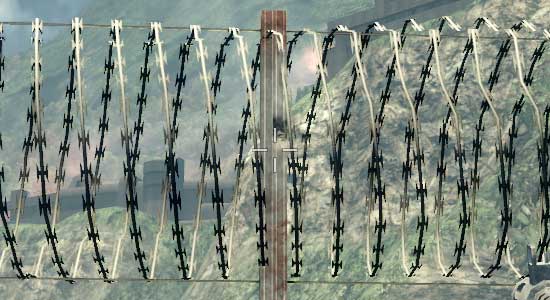
Bad Company 2 DX11 With Transparency Supersampling
The bad news is that it’s not quite complete. Oh as you’ll see in our screenshots it works, but the performance hit is severe. It’s currently super-sampling too much, resulting in massive performance drops. NVIDIA is telling us that this should be fixed next month, at which time the performance hit should be similar to that of the old TrSS mode under DX9. We’ve gone ahead and taken screenshots and benchmarks of the current implementation, but keep in mind that performance should be greatly improving next month.
So with that said, let’s look at the screenshots.

| NVIDIA GeForce GTX 480 | NVIDIA GeForce GTX 285 | ATI Radeon HD 5870 | ATI Radeon HD 4890 |
| 0x | 0x | 0x | 0x |
| 2x | 2x | 2x | 2x |
| 4x | 4x | 4x | 4x |
| 8xQ | 8xQ | 8x | 8x |
| 16xQ | 16xQ | DX9: 4x | DX9: 4x |
| 32x | DX9: 4x | DX9: 4x + AAA | DX9: 4x + AAA |
| 4x + TrSS 4x | DX9: 4x + TrSS | DX9: 4x + SSAA | |
| DX9: 4x | |||
| DX9: 4x + TrSS |
With the exception of NVIDIA’s new TrSS mode, very little has changed. Under DX10 all of the cards produce a very similar image. Furthermore once you reach 4x MSAA, each card producing a near-perfect image. NVIDIA’s new TrSS mode is the only standout for DX10.
We’ve also include a few DX9 shots, although we are in the process of moving away from DX9. This allows us to showcase NVIDIA’s old TrSS mode, along with AMD’s Adapative AA and Super-Sample AA modes. Note how both TrSS and AAA do a solid job of anti-aliasing the foliage, which makes it all the more a shame that they haven’t been available under DX10.
When it comes to performance, keep in mind that both AMD and NVIDIA have been trying to improve their 8x MSAA performance. When we reviewed the Radeon 5870 back in September we found that AMD’s 8x MSAA performance was virtually unchanged, and 6 months later that still holds true. The performance hit moving from 4x MSAA to 8x MSAA on both Radeon cards is roughly 13%. NVIDIA on the other hand took a stiffer penalty under DX10 for the GTX 285, where there it fell by 25%. But now with NVIDIA’s 8x MSAA performance improvements for Fermi, that gap has been closed. The performance penalty for moving to 8x MSAA over 4x MSAA is only 12%, putting it right up there with the Radeon cards in this respect. With the GTX 480, NVIDIA can now do 8x MSAA for as cheap as AMD has been able to
Meanwhile we can see the significant performance hit on the GTX 480 for enabling the new TrSS mode under DX10. If NVIDIA really can improve the performance of this mode to near-DX9 levels, then they are going to have a very interesting AA option on their hands.
Last but not least, there’s anisotropic filtering quality. With the Radeon 5870 we saw AMD implement true angle-independent AF and we’ve been wondering whether we would see this from NVIDIA. The answer is no: NVIDIA’s AF quality remains unchanged from the GTX200 series. In this case that’s not necessarily a bad thing; NVIDIA already had great AF even if it was angle-dependant. More to the point, we have yet to find a game where the difference between AMD and NVIDIA’s AF modes have been noticeable; so technically AMD’s AF modes are better, but it’s not enough that it makes a practical difference
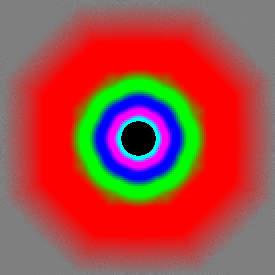
GeForce GTX 480

GeForce GTX 285
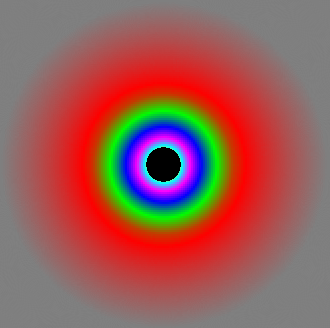
Radeon 5870


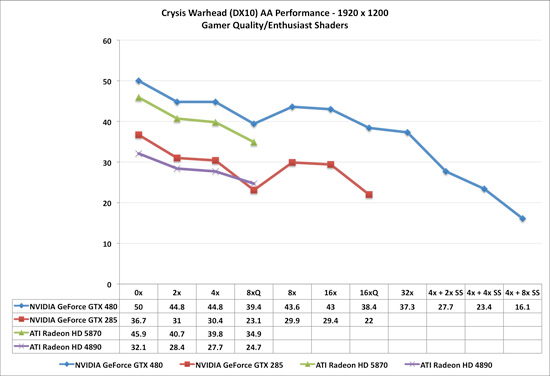
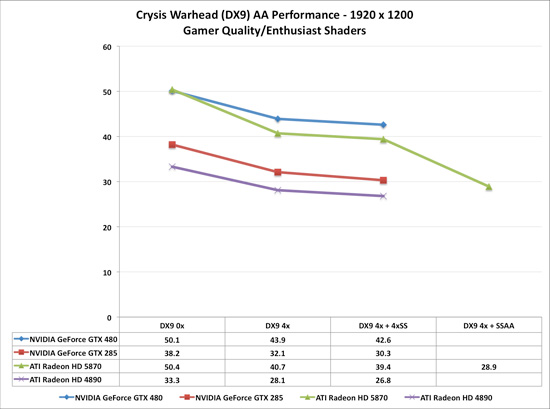








196 Comments
View All Comments
henrikfm - Tuesday, March 30, 2010 - link
Now it would be easier to believe only idiots buy ultra-high end PC hardware parts.ryta1203 - Tuesday, March 30, 2010 - link
Is it irresponsible to use benchmarks desgined for one card to measure the performance of another card?Sadly, the "community" tries to hold the belief that all GPU architectures are the same, which is of course not true.
The N-queen solver is poorly coded for ATI GPUs, so of course, you can post benchmarks that say whatever you want them to say if they are coded that way.
Personally, I find this fact invalidates the entire article, or at least the "compute" section of this article.
Ryan Smith - Wednesday, March 31, 2010 - link
One of the things we absolutely wanted to do starting with Fermi is to include compute benchmarks. It's going to be a big deal if AMD and NVIDIA have anything to say about it, and in the case of Fermi it's a big part of the design decision.Our hope was that we'd have some proper OpenCL/DirectCompute apps by the time of the Fermi launch, but this hasn't happened. So our decision was to go ahead with what we had, and to try to make it clear that our OpenCL benchmarks were to explore the state of GPGPU rather than to make any significant claims about the compute capabilities of NVIDIA or AMD's GPUs. We would rather do this than to ignore compute entirely.
It sounds like we didn't make this clear enough for your liking, and if so I apologize. But it doesn't make the results invalid - these are OpenCL programs and this is what we got. It just doesn't mean that these results will carry over to what a commercial OpenCL program may perform like. In fact if anything it adds fuel to the notion that OpenCL/DirectCompute will not be the great unifier we had hoped for them to be if it means developers are going to have to basically write paths optimized around NVIDIA and AMD's different shader structure.
ryta1203 - Tuesday, March 30, 2010 - link
The compute section of this article is just nonsense. Is this guy a journalist? What does he know about programming GPUs?Firen - Tuesday, March 30, 2010 - link
Thanks for this comprehensive review, it covers some very interesting topics betwen Team Green and Team Red.Yet, I agree with one of the comments here, you missed how easy that ATI 5850 and 5870 can be overlocked thanks to their lite design, a 5870 can easily deliver more or less the same performance as a 480 card while still running cooler and consumes less power..
Some people might point out that our new 'champion' card can be overlocked as well..that's true..however, doesn't it feel terrifying to have a graphic card running hotter than boiling water!
Fulle - Tuesday, March 30, 2010 - link
I wonder what kind of overclocking headroom the 470 has.... since someone with a 5850 can easily bump the voltage up a smidge, and get about a 30% overclock with minimal effort... people who tinker can usually safely reach about 1GHz core, for about a 37% overclock.Unless the 470 has a bit of overclocking headroom, someone with a 5850 could easily overclock to have superior performance, lower heat, lower noise, and lower power consumption.
After all these months and months of waiting, Nvidia has basically released a few products that ATI can defeat by just binning their current GPUs and bumping up the clockspeed? *sigh* I really don't know who would buy these cards.
Shadowmaster625 - Tuesday, March 30, 2010 - link
You're being way too kind to Nvidia. Up to 50% more power consumption for a very slight (at best) price/performance advantage? This isnt a repeat of the AMD/Intel thing. This is a massive difference in power consumption. We're talking about approximately $1 a year per hour a week of gaming. If you game for 20 hours a week, expect to pay $20 a year more for using the GTX470 vs a 5850. May as well add that right to the price of the card.But the real issue is what happens to these cards when they get even a modest coating of dust in them? They're going to detonate...
Even if the 470 outperformed the 5850 by 30%, I dont think it would be worth it. I cant stand loud video cards. It is totally unacceptable to me. I again have to ask the question I find myself asking quite often: what kind of world are you guys living in? nVidia should get nothing more than a poop-in-a-box award for this.
jujumedia - Wednesday, March 31, 2010 - link
with those power draws and the temps it reaches for daily operation i see gpu failure rates high on the gtx 480 and 470 as they are already faulty from the fab lab. Ill stick with ATI for 10 fps less.njs72 - Wednesday, March 31, 2010 - link
I been holding on for months to see what Fermi would bring in the world of GPUs. After reading countless reviews of this card i dont think its a justifyable upgrade for my gtx260. I mean yeah the performance is much higher but in most reviews of benchmarks with games like Crysis this card barely wins against the 5870, but buying this card i would need to upgrade the psu and posibly a new case for ventilation. I keep loading up Novatechs website and and almost adding a 5870 to the basket, and not pre ordering gtx480 like i was intending. What puts me off more than anything with the new nvidia card is its noise and temps. I cant see this card living for very long.Ive been a nvidia fan ever since the the first geforce card came out, which i still have tucked away in a draw somewhere. I find myself thinking of switching to ATI, but read too many horror stories about their driver implementation that puts me off. Maybe i should just wait for Nvidia to refresh its new card and keep hold of my 260 for a bit longer. i really dont know :-(
Zaitsev - Wednesday, March 31, 2010 - link
There is an error with the Bad Company 2 image mouse overs for the GTX 480. I think the images for 2xAA and 4xAA have been mixed up. 2xAA clearly has more AA than the 4xAA image.Compare GTX 480 2x with GTX 285 4x and they look very similar. Also compare 480 4x with 285 2x.
Very nice article, Ryan! I really enjoyed the tessellation tests. Keep up the good work.